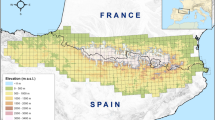Abstract.
Biogeographical affinities among cloud forests in the Neotropical region were studied through a track approach, by constructing generalised tracks based on the results of a parsimony analysis of endemicity (PAE). Distributional data on 946 genera and 1,266 species of vascular plants (Pteridophyta, angiosperms, and gymnosperms) from 26 cloud forest patches from Colombia, Costa Rica, Cuba, Honduras, Jamaica, Mexico, Peru, Puerto Rico, and Venezuela were analysed; and four localities from eastern and western United States were also included as outgroups. The track analysis identified six generalised tracks: a first one that includes the majority of the cloud forests of Mexico, Central America, the Antilles, and northern Colombia; a second one that includes southern Mexico and northern Central America; a third one that includes the mountains in northwestern South America; a fourth one that includes the mountains in southwestern South America; and two others in western and eastern United States. It is concluded that the Neotropical cloud forests are closely related and that those of the Caribbean subregion exhibit complex relationships, which could be due to the complex tectonic history of the area.
Similar content being viewed by others
Author information
Authors and Affiliations
Additional information
Received February 22, 2001 Accepted May 1, 2001
Rights and permissions
About this article
Cite this article
Luna-Vega, I., Morrone, J., Ayala, O. et al. Biogeographical affinities among Neotropical cloud forests. Plant Syst. Evol. 228, 229–239 (2001). https://doi.org/10.1007/s006060170031
Issue Date:
DOI: https://doi.org/10.1007/s006060170031




